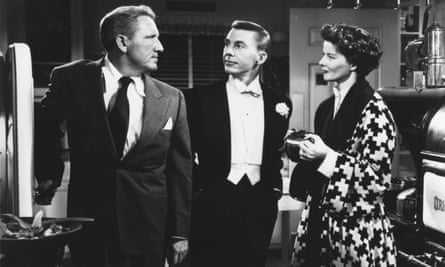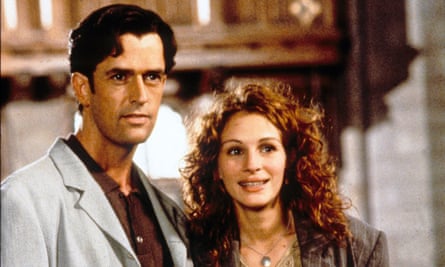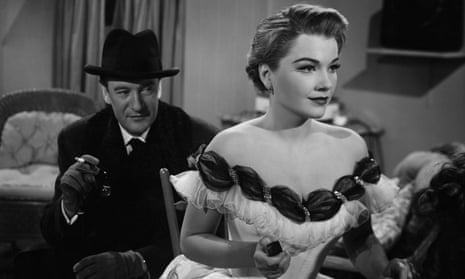Before the gay best friend could be phased out, he had to come out. Today, those three short words tend to denote the most confining limitations to queer characters in film, a trope and archetype designed to keep homosexuality on the sidelines, adjacent to the more palatable lives and loves of straight people. For a time, however, sassy support was about the best representation queer people could hope for on screen, even if it required some code-reading on the viewer’s part. In Code-era Hollywood, ascribing a sexuality at all to the waspish single man commenting on, or even assisting in, the protagonists’ own entanglement would have been a detail too far. He had a name, a role, a handful of good lines. What more could he want – an identity?
Curated by the critic Michael Koresky, a mini-season of films on the Criterion Channel in June affords some depth and dignity to a character often demeaned as a patronising relic of now-outdated prejudices – even as it persists in film and TV today. Koresky’s selection delves beyond the romantic comedy realm where the trope made its most enduring impression, and into the realist dramas, psycho-thrillers and unclassifiable art films (Irma Vep, most unexpectedly) through which the gay best friend has evolved from a type to a human being.
But a type was enough, in the 1930s and 1940s, to keep character actors like the superbly named Franklin Pangborn busy in romps like Stage Door and the Preston Sturges-written Easy Living, playing one variation after another of the same man: fastidious, fast-talking, archly knowing but otherwise sexless. Edward Everett Horton and Grady Sutton, Pangborn’s contemporaries in the bracket of gay actors dubbed “Hollywood sissies”, extended the stereotype into bumbling or hayseed comic territory. (Once in a while they even got to play ostensibly straight characters, albeit never manly ones.)
By 1949’s spritz Katharine Hepburn-Spencer Tracy romcom Adam’s Rib, the gay sidekick could be not just a brittle functionary – a butler, a manager, a milliner – but an actual pal, even a foil of sorts. Played by the straight, wiry character actor David Wayne, the singer and pianist Kip is a fun-loving neighbour to Hepburn’s married New York lawyer Amanda, though there’s enough of a seductive edge to his carousing with her to aggravate her husband. There’s joy away from heteronormativity, Kip seems to suggest; the film, directed by the famously gay George Cukor, feels cheerfully complicit in that truth even as it obeys the rules of straight romance.

It’s certainly a sunnier presentation of queer masculinity than the suavely coded gossip columnist and gadfly Addison DeWitt in All About Eve: played to Oscar-winning effect by George Sanders, he’s a best friend to everyone and no one, his sexuality implied not so much through his mannerisms (as Sanders steers clear of flouncy parody) as through his proudly owned otherness, his sinuous traversing of social sects: “We are the original displaced personalities,” he says at one point, referring to theatre folk. The secondary implication is clear enough.
But things would get more complicated; the gay best friend’s self-assurance would wobble. In the generation-marking teen-ennui drama Rebel Without a Cause, the bisexual actor Sal Mineo took the archetype into tragic (albeit still nominally veiled) territory, his shy social outcast Plato ultimately too besotted with James Dean’s smouldering hero to make it to the end of the film. In the 1960s, a new wave of social-realist films finally outed their gay best friend characters in a sympathetic light.
Britain gave us The L-Shaped Room, in which a Black gay musician helpfully mirrors the outsider status of Leslie Caron’s single, pregnant heroine, and A Taste of Honey, where the likewise knocked-up Rita Tushingham’s gentle gay housemate even offers to marry her, with a line that practically distils the archetype’s role across film history: “You need somebody to love you while you’re looking for somebody to love.” Over in the US, Paul Newman’s Rachel, Rachel offered a female version in the character actor Estelle Parson’s Calla, a lesbian confidante to Joanne Woodward’s eponymous protagonist, a repressed, virginal schoolmarm; Calla attempts to answer Rachel’s loneliness with a kiss, briskly rebuffed, hinting at a story Hollywood wasn’t yet ready to tell. By 1983’s Silkwood, the lesbian best friend – played with gruff wit by a surprisingly cast Cher – could be granted a lover of her own.
So, eventually, could her male counterpart, even if the sexual revolution of the 1970s, countered by the Aids panic and Reaganite homophobia of the 1980s, hadn’t done much to promote him from the margins in mainstream cinema. In 1991’s Frankie and Johnny, the gay best friend could take the form of a couple – Nathan Lane and Sean O’Bryan – providing healthy romantic counsel to an improbably lovelorn Michelle Pfeiffer. In 1994’s Four Weddings and a Funeral, the one couple that can’t get legally married gives ballast to the film’s heterosexual frolics: John Hannah’s Auden-borrowed elegy for Simon Callow is the scene everyone remembers.

Rupert Everett, devoted gay right-hand man to Julia Roberts’s romantic schemer in My Best Friend’s Wedding, doesn’t get a partner but does get to advocate the acceptability of singled – for him and the straight heroine alike – by the film’s end. He was sufficiently popular to prompt a rash of relationship movies where the gay best friend is promoted to leading man: in The Object of My Affection, Paul Rudd is the ideal partner that Jennifer Aniston wants but fundamentally cannot have; in the wretched The Next Best Thing, Everett fathers a child with Madonna, only for her subsequent heterosexual romance to drive them apart. In both films, the gay man got an upgrade in billing if not in agency, remaining a mere facilitator to a woman’s wellbeing.
And what now, with gay romance no longer the red line it was in the movies, with queerness no longer strictly a fringe concern? Well, the gay best friend endures, though sometimes he has company in the protagonist: Richard E Grant’s tart drinking buddy to Melissa McCarthy’s down-at-heel writer Lee Israel in Can You Ever Forgive Me? is in all respects a classic of the type, save for the fact that Lee herself is queer, protagonist and sidekick bonded in otherness. In Todd Haynes’s Carol, Cate Blanchett’s closeted title character is supported in her homosexuality by a best friend (Sarah Paulson) who’s been through it all before. And at the contemporary end of the spectrum, the gay protagonists of Heartstopper may struggle with age-old identity crises, but a diverse social group – including transgender best friend Elle – assists with their self-realisation. The gay best friend may not be an obsolete archetype anymore, but it’s no longer an isolated one.
Queersighted: The Gay Best Friend is now available on the Criterion Channel

Comments (…)
Sign in or create your Guardian account to join the discussion